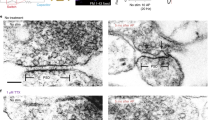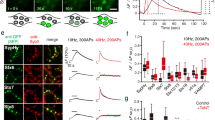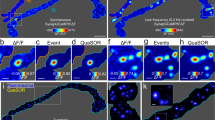Abstract
To sustain high rates of transmitter release, synaptic terminals must rapidly re-supply vesicles to release sites and prime them for exocytosis. Here we describe imaging of single synaptic vesicles near the plasma membrane of live ribbon synaptic terminals. Vesicles were captured at small, discrete active zones near the terminal surface. An electric stimulus caused them to undergo rapid exocytosis, seen as the release of a fluorescent lipid from the vesicles into the plasma membrane. Next, vesicles held in reserve about 20 nm from the plasma membrane advanced to exocytic sites, and became release-ready 250 ms later. Apparently a specific structure holds vesicles at an active zone to bring v-SNAREs and t-SNAREs, the proteins that mediate vesicle fusion, within striking distance of each other, and then allows the triggered movement of such vesicles to the plasma membrane.
This is a preview of subscription content, access via your institution
Access options
Subscribe to this journal
Receive 51 print issues and online access
$199.00 per year
only $3.90 per issue
Buy this article
- Purchase on Springer Link
- Instant access to full article PDF
Prices may be subject to local taxes which are calculated during checkout






Similar content being viewed by others
References
Liley, A. W. & North, K. A. K. An electrical investigation of effects of a repetitive stimulation on mammalian neuromuscular junction. J. Neurophysiol. 16, 509– 527 (1953).
Zucker, R. S. Exocytosis: a molecular and physiological perspective. Neuron 17, 1049–1055 (1996).
Neher, E. Vesicle pools and Ca2+ microdomains: new tools for understanding their roles in neurotransmitter release. Neuron 20, 389–399 (1998).
Wu, L. G. & Borst, J. G. The reduced release probability of releasable vesicles during recovery from short-term synaptic depression. Neuron 23, 821–832 (1999).
Schneggenburger, R., Meyer, A. C. & Neher, E. Released fraction and total size of a pool of immediately available transmitter quanta at a calyx synapse. Neuron 23, 399–409 (1999).
Mennerick, S. & Matthews, G. Ultrafast exocytosis elicited by calcium current in synaptic terminals of retinal bipolar neurons. Neuron 17, 1241–1249 ( 1996).
Sakaba, T., Tachibana, M., Matsui, K. & Minami, N. Two components of transmitter release in retinal bipolar cells: exocytosis and mobilization of synaptic vesicles. Neurosci. Res. 27, 357–370 (1997).
von Gersdorff, H., Sakaba, T., Berglund, K. & Tachibana, M. Submillisecond kinetics of glutamate release from a sensory synapse. Neuron 21, 1177–1188 (1998).
Neves, G. & Lagnado, L. The kinetics of exocytosis and endocytosis in the synaptic terminal of goldfish retinal bipolar cells. J. Physiol. (Lond.) 515, 181–202 (1999).
Steyer, J. A., Horstmann, H. & Almers, W. Transport, docking and exocytosis of single secretory granules in live chromaffin cells. Nature 388, 474–478 (1997).
Oheim, M., Loerke, D., Stuhmer, W. & Chow, R. H. The last few milliseconds in the life of a secretory granule. Docking, dynamics and fusion visualized by total internal reflection fluorescence microscopy (TIRFM). Eur. Biophys. J. 27, 83–98 (1998).
Han, W., Ng, Y. K., Axelrod, D. & Levitan, E. S. Neuropeptide release by efficient recruitment of diffusing cytoplasmic secretory vesicles. Proc. Natl Acad. Sci. USA 96, 14577– 14582 (1999).
Lang, T. et al. Role of actin cortex in the subplasmalemmal transport of secretory granules in PC-12 cells. Biophys. J. 78, 2863–2877 (2000).
Schmoranzer, J., Goulian, M., Axelrod, D. & Simon, S. M. Imaging constitutive exocytosis with total internal reflection fluorescence microscopy. J. Cell Biol. 149, 23–32 (2000).
Toomre, D., Steyer, J. A., Keller, P., Almers, W. & Simons, K. Fusion of constitutive membrane traffic with the cell surface observed by evanescent wave microscopy. J. Cell Biol. 149, 33–40 (2000).
Betz, W. J. & Bewick, G. S. Optical analysis of synaptic vesicle recycling at the frog neuromuscular junction. Science 255, 200–203 (1992).
Ryan, T. A., Reuter, H. & Smith, S. J. Optical detection of a quantal presynaptic membrane turnover. Nature 388, 478– 482 (1997).
Murthy, V. N. & Stevens, C. F. Synaptic vesicles retain their identity through the endocytic cycle. Nature 392, 497–501 (1998).
von Gersdorff, H., Vardi, E., Matthews, G. & Sterling, P. Evidence that vesicles on the synaptic ribbon of retinal bipolar neurons can be rapidly released. Neuron 16, 1221– 1227 (1996).
Lagnado, L., Gomis, A. & Job, C. Continuous vesicle cycling in the synaptic terminal of retinal bipolar cells. Neuron 17, 957–967 (1996).
Rouze, N. C. & Schwartz, E. A. Continuous and transient vesicle cycling at a ribbon synapse. J. Neurosci. 18, 8614–8624 (1998).
Takei, K., Mundigl, O., Daniell, L. & De Camilli, P. The synaptic vesicle cycle: a single vesicle budding step involving clathrin and dynamin. J. Cell Biol. 133, 1237– 1250 (1996).
Schmidt, A., Hannah, M. J. & Huttner, W. B. Synaptic-like microvesicles of neuroendocrine cells originate from a novel compartment that is continuous with the plasma membrane and devoid of transferrin receptor. J. Cell Biol. 137 , 445–458 (1997).
Zhang, B. et al. Synaptic vesicle size and number are regulated by a clathrin adaptor protein required for endocytosis. Neuron 21 , 1465–1475 (1998).
von Gersdorff, H. & Matthews, G. Inhibition of endocytosis by elevated internal calcium in a synaptic terminal. Nature 370, 652–655 ( 1994).
Kobayashi, K. & Tachibana, M. Ca2+ regulation in the presynaptic terminals of goldfish retinal bipolar cells. J. Physiol. (Lond.) 483, 79–94 ( 1995).
Smith, C. B. & Betz, W. J. Simultaneous independent measurement of endocytosis and exocytosis. Nature 380, 531–534 (1996).
Betz, W. J., Mao, F. & Smith, C. B. Imaging exocytosis and endocytosis. Curr. Opin. Neurobiol. 6, 365–371 ( 1996).
Betz, W. J. & Bewick, G. S. Optical monitoring of transmitter release and synaptic vesicle recycling at the frog neuromuscular junction. J. Physiol. (Lond.) 460, 287– 309 (1993).
Gray, E. G. & Pease, H. L. On understanding the organisation of the retinal receptor synapses. Brain Res. 35, 1–15 (1971).
Raviola, E. & Gilula, N. B. Intramembrane organization of specialized contacts in the outer plexiform layer of the retina. A freeze-fracture study in monkeys and rabbits. J. Cell Biol. 65, 192–222 (1975).
Lenzi, D., Runyeon, J. W., Crum, J., Ellisman, M. H. & Roberts, W. M. Synaptic vesicle populations in saccular hair cells reconstructed by electron tomography. J. Neurosci. 19, 119–132 (1999).
Issa, N. P. & Hudspeth, A. J. Clustering of Ca2+ channels and Ca(2+)-activated K+ channels at fluorescently labeled presynaptic active zones of hair cells. Proc. Natl Acad. Sci. USA 91, 7578–7582 (1994).
Sutton, R. B., Fasshauer, D., Jahn, R. & Brunger, A. T. Crystal structure of a SNARE complex involved in synaptic exocytosis at 2.4 A resolution. Nature 395, 347–353 ( 1998).
Lowe, M., Nakamura, N. & Warren, G. Golgi division and membrane traffic. Trends Cell Biol. 8, 40–44 ( 1998).
Heidelberger, R. & Matthews, G. Calcium influx and calcium current in single synaptic terminals of goldfish retinal bipolar neurons. J. Physiol. (Lond.) 447, 235– 256 (1992).
Stout, A. L. & Axelrod, D. Evanescent field excitation of fluorescence by epi-illumination microscopy. Appl. Opt. 28, 5237–5242 (1989).
Steyer, J. A. & Almers, W. Tracking single secretory granules in live chromaffin cells by evanescent-field fluorescence microscopy. Biophys. J. 76, 2262–2271 (1999).
Axelrod, D., Hellen, E. H. & Fulbright, R. M. in Topics in Fluorescence Spectroscopy, Volume 3: Biomedical Applications (ed. Lakowicz, J. R.) 289– 343 (Plenum, New York, 1992).
Parsons, T. D., Coorssen, J. R., Horstmann, H. & Almers, W. Docked granules, the exocytic burst, and the need for ATP hydrolysis in endocrine cells. Neuron 15, 1085– 1096 (1995).
Acknowledgements
This work was spported by a grant from the NIH (W.A.) and by the Max Planck Society. D.Z. was supported by an NIH Training Program in Neuronal Signaling and J.A.S. by a fellowship from the Max Planck Society. We thank M. Feldman for his comments on the manuscript.
Author information
Authors and Affiliations
Rights and permissions
About this article
Cite this article
Zenisek, D., Steyer, J. & Almers, W. Transport, capture and exocytosis of single synaptic vesicles at active zones. Nature 406, 849–854 (2000). https://doi.org/10.1038/35022500
Received:
Accepted:
Issue Date:
DOI: https://doi.org/10.1038/35022500
This article is cited by
-
Recent progress in three-terminal artificial synapses based on 2D materials: from mechanisms to applications
Microsystems & Nanoengineering (2023)
-
Transmission at rod and cone ribbon synapses in the retina
Pflügers Archiv - European Journal of Physiology (2021)
-
Synaptic ribbons foster active zone stability and illumination-dependent active zone enrichment of RIM2 and Cav1.4 in photoreceptor synapses
Scientific Reports (2020)
-
Simultaneous electrophysiological and morphological assessment of functional damage to neural networks in vitro after 30–300 g impacts
Scientific Reports (2019)
-
In Vivo Ribbon Mobility and Turnover of Ribeye at Zebrafish Hair Cell Synapses
Scientific Reports (2017)
Comments
By submitting a comment you agree to abide by our Terms and Community Guidelines. If you find something abusive or that does not comply with our terms or guidelines please flag it as inappropriate.



